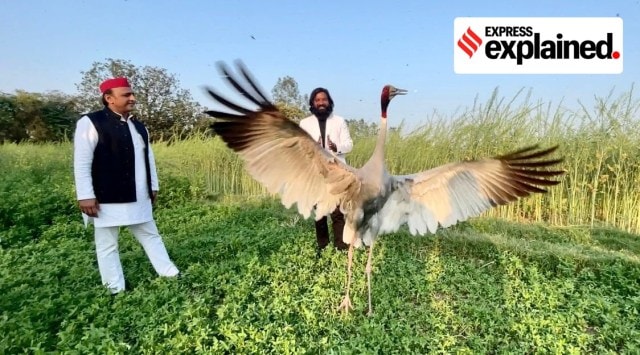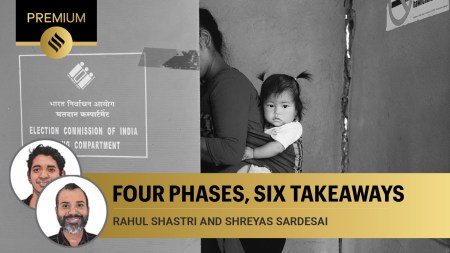- India
- International
Arif and his Sarus: The special bond between crane, Indian farmer
Once treated by Arif, the Sarus crane had no future in the wild. But a happy bird does not belong to a zoo or its caregiver in jail. The wisest recourse, therefore, is to reunite the two, and let them be.
 Last February, 35-year-old Mohammad Arif (right) brought home an injured Sarus crane he found in his village of Mandhka in Uttar Pradesh’s Amethi district. Samajwadi Party leader Akhilesh Yadav (left) recently met him and the bird. (Twitter/@yadavakhilesh)
Last February, 35-year-old Mohammad Arif (right) brought home an injured Sarus crane he found in his village of Mandhka in Uttar Pradesh’s Amethi district. Samajwadi Party leader Akhilesh Yadav (left) recently met him and the bird. (Twitter/@yadavakhilesh) In February 2022, 35-year-old Mohammad Arif brought home an injured Sarus crane he found in his village of Mandhka in Uttar Pradesh’s Amethi district. The bird recovered in time but never left him. Recently, the duo became famous on social media, and officials came knocking.
Last week, Arif was booked under the wildlife laws, and the bird was packed off first to a neighbourhood sanctuary and then to the Kanpur zoo.
What is the problem with rescuing a Sarus or animals?
Across the globe, rescuing wildlife at will is not permitted. This is because many such animals are not in need of rescuing. For example, wild cats leave their cubs to go hunting only to find them missing (rescued) on return. Also, many rescuers may not be equipped to either help the animals or ensure they do not become a threat to public health.
In 2019, for example, a singer made headlines for keeping a sun bear in her Kuala Lumpur condominium. She claimed to have found the animal in a weakened state and decided to nurse it back to health. A Malaysian court tried her under the country’s wildlife laws. More recently in 2021, a woman was charged for rescuing wildlife without a permit in Michigan, USA. The Department of Natural Resources arrested her after euthanising six of her animals, including a two-week-old deer.
What about India?
Under Section 39 of the Wildlife (Protection) Act, no person is allowed to acquire or keep in his possession, custody or control any wildlife which is state property. If anyone does so — for example, to treat an injured bird as in the present case — she must report it to the nearest police station or the authorised officer within forty-eight hours of obtaining such possession. Further, under Section 57 of the Act, if a person is found in possession, custody or control of any wildlife, the burden of proof for establishing that the possession, custody or control is not illegal is on the person.

Clearly, WLPA does not allow anyone to take home an injured wild bird and keep it for months without written permission from the state’s chief wildlife warden. But it gets a little complicated when the bird in question is a Sarus crane and the caregiver is a farmer in Uttar Pradesh.
What is special about the Sarus?
Back in 1861, British ornithologist LH Irby wrote about Sarus cranes he observed in Oudh: “The young birds are easily reared by hand, and become very tame and attached to the person who feeds them, following him like a dog.”
The behaviour was explained after 75 years when Austrian zoologist Lorenz Konrad described how young precocial birds (those born with all their feather and able to see and move around immediately) learn to follow real or foster parents. Called imprinting, the process starts with hatching so that the chics follow the appropriate adult for safety.
KS Gopi Sundar, editor-in-chief of the Waterbirds Society, and the co-chair of the IUCN Stork, Ibis and Spoonbill Specialist Group, who has worked on Sarus cranes since 1998, observed that the window for imprinting could remain open until a Sarus crane pairs with another.
“In all probability, the bird in question was a young unpaired one from a flock of non-breeding Sarus cranes and that is why it bonded readily during treatment,” he said, adding that the species is anyway well accustomed to farmers and has been thriving in good numbers since the Green revolution.
What is farmers’ attitude to the Sarus?
Unlike in South-East Asia, Indian farmers have traditionally tolerated the species in their fields. So much so that the species adjusted its breeding behaviour after human activities. For example, unlike elsewhere in its global range, Sarus cranes in India do not wait for the onset of monsoon to start breeding but take the cue from farmers flooding their fields in anticipation of rain.
Barring some small farmers who resent the omnivorous bird for damaging their crops, the larger community has accepted the species for its deep cultural associations. As the story goes, sage Valmiki cursed a hunter for killing the male of a pair of courting Sarus cranes and the words took the form of a perfect verse, inspiring him to compose the epic.
At the same time, the farming community also appreciates the material benefits of having Sarus cranes in their fields. The bird, particularly chicks, are voracious eaters of mice and other pests. In the night, their shrill calls alert farmers to crop-raiding nilgais and, increasingly, feral cattle.
And what next?
Given the biological inclination of the species to bond easily, individual Sarus cranes have moved with people on many occasions. For example, back in 1989, eminent photographer Raghu Rai famously documented how a Sarus crane, onomatopoeically named Kurrkutt, lived with a family in Khajuraho, feeding on chapatis.
The species is neither a novelty nor under threat in the Northern Indian landscape. Therefore, following the letter of the wildlife law blindly may set damaging precedence.
“In many zoos around the world, cranes have bonded with caretakers. Once that happens, the bird is usually not ‘fit’ for release in the wild because the chances of it bonding with another crane reduce substantially,” said Gopi Sundar.
Once treated by Arif, the Sarus crane had no future in the wild. But a happy bird does not belong to a zoo or its caregiver in jail. The wisest recourse, therefore, is to reunite the two, and let them be.
More Explained
EXPRESS OPINION
May 17: Latest News
- 01
- 02
- 03
- 04
- 05









































